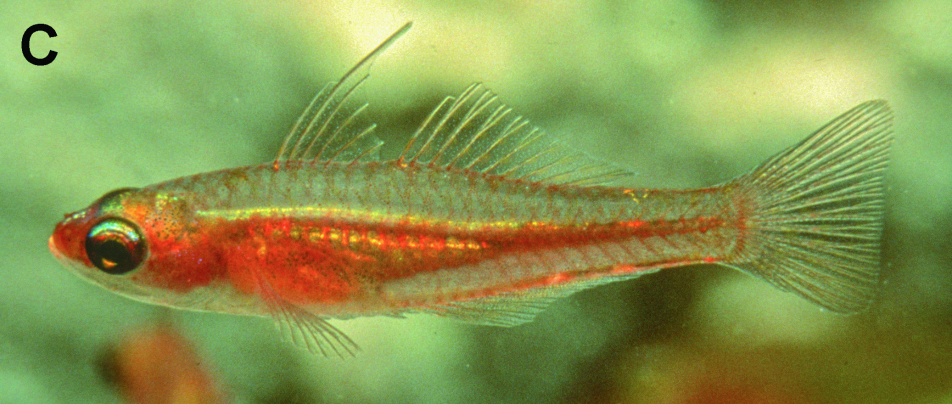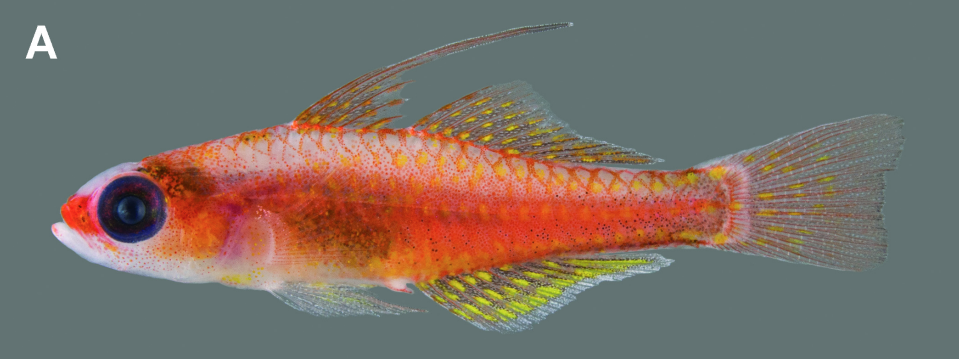A new species of Trimma goby has been described from the Saudi Arabian coast of the Red Sea. Named the Rift Pygmygoby, Trimma nubarum was formerly identified as Trimma taylori, only closer inspection by Winterbottom, Bogorodsky, and Alpermann revealed that the Red Sea “taylori” differed from those in the Indo-Pacific by having fewer dorsal, anal and pectoral fin rays, and differing cycloid versus ctenoid scales.
The researchers also found that specimens from the Red Sea “form a monophyletic lineage in a Maximum Likelihood analysis of the COI gene. In this tree, the new species is the sister group to a clade composed of three lineages. One is composed of specimens from the Maldives, which is the sister group of a single available specimen from the Seychelles. These two together are the sister group of specimens of a widespread western Pacific clade.”

The Trimma genus now contains 111 valid species of small, colorful gobies that primarily inhabit reefs in the Indo-Pacific, but Winterbottom says that gene research may reveal a plethora of cryptic species that could double that number, let alone new additions found in the deepwater mesophotic zone.
The original Trimma taylori was described in 1979 based on specimens from Oahu in the Hawaiian Islands and given a wide geographic range, but in 2019, Winterbottom suggested that the species’ range should be restricted to Hawaii. In 2020 Winterbottom et al. demonstrated the presence of five haplogroups within the T. taylori species group, one of which was represented by specimens from the Red Sea (arbitrarily designated as Group 1c). Specimens from the Hawaiian Islands were found to be part of one haplogroup (arbitrarily designated as Group 1b) together with some samples from Palau and eastern Indonesia, and the name T. taylori is available for these specimens.

The new Rift Pygmygoby, Trimma nubarum, holotype is a 15.8mm long female collected from Malathu Island in the Red Sea. It was collected in 2014 from a reef wall with small caves at 22-23, depth. The paratypes are all similar in size, and collected from similar habitats in very similar depths of 16-29 meters. Trimma nubarum is considered a Red Sea endemic, and occurs from the Gulf of Aqaba at Dahab (SVB) south to central Saudi Arabia and to Saunders Reef off Eritrea. It has been observed hovering in aggregations of up to 15 individuals near the roof of caves and moving to shelter in the cave roof when approached by divers.
The name “nubarum” is derived from a combination of the first three letters of the Nubian and the first two letters of the Arabian continental plates (= “nubar”) whose divergence forms the great rift of which the Red Sea is a part.
To read the full paper go to DOI: 10.11646/ZOOTAXA.5353.3.3
Image A shows a freshly collected holotype, of Trimma nubarum, SMF 35730, 15.8 mm SL, female, Al Lith, Saudi Arabia, Red Sea. Photos: A & B—S. V. Bogorodsky; C—G. Barrall.



